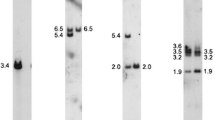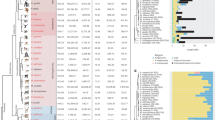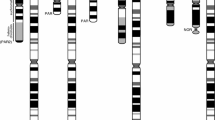Abstract
Cytogenetic studies of the primate Y chromosomes have suggested that extensive rearrangements have occurred during evolution of the great apes. We have usedin situ hybridization to define these rearrangements at the molecular level.pHU-14, a probe including sequences from the sex determining geneSRY, hybridizes close to the early replicating pseudoautosomal segment in a telomeric or subtelomeric position of the Y chromosomes of all great apes. The low copy repeat detected by the probeFr35-II is obviously included in Y chromosomal rearrangements during hominid evolution. These results, combined with previous studies, suggest that the Y chromosome in great apes has a conserved region including the pseudoautosomal region and the testis-determining region. The rest of the Y chromosome has undergone several rearrangements in the different great apes.
Similar content being viewed by others
References
Arnold N, Seibl R, Kessler C, Wienberg J (1992) Nonradioactivein situ hybridization with digoxigenin labeled DNA probes. Biotech Histochem67: 59–67.
Bengtsson BO, Goodfellow PN (1987) The effect of recombination between the X and Y chromosomes of mammals.Ann Hum Genet 51: 57–64.
Cooke HJ, Brown WAR, Rappold GA (1985) Hypervariable telomeric sequences from the human sex chromosomes are pseudoautosomal.Nature 317: 687–692.
Disteche CM, Brannan CI, Larsen Aet al. (1992) The human pseudoautosomal GM-CSF receptor α subunit gene is autosomal in mouse.Nature Genet 1: 333–336.
Ellis N, Yen P, Neiswanger K, Shapiro LJ, Goodfellow PN (1990) Evolution of the peudoautosomal boundary in Old World monkeys and great apes.Cell 633: 977–986.
Goodfellow PJ, Darling SM, Thomas NS, Goodfellow PN (1986) A pseudoautosomal gene in man.Science 234: 740–743.
Harbers K, Franke U, Soriano P, Jaenisch R, Müller U (1990) Structure and chromosomal mapping of a highly polymorphic repetitive DNA sequence from the pseudoautosomal region of the mouse sex chromosomes.Cytogenet Cell Genet 53: 129–133.
Keitges E, Rivest M, Siniscalco M, Gartler SM (1985) X-linkage of steroid sulfatase in the mouse is evidence for a functional Y-linked allele.Nature 315: 226–227.
Lichter P, Cremer T, Borden J, Manuelidis L, Ward DD (1988) Delineation of individual human chromosomes in metaphase and interphase cells byin situ suppression hybridization using recombinant DNA libraries.Hum Genet 80: 224–234.
Müller G, Schempp W (1991) Comparative mapping ofZFY in the hominoid apes.Hum Genet 88: 59–63.
Ohno S (1967)Sex Chromosomes and Sex-linked Genes. New York: Springer.
Rouyer F, De la Chapelle A, Andersson M, Weissenbach J (1990) An interspersed repeated sequence specific for human subtelomeric regions.EMBO J 9: 505–514.
Schempp W, Meer B (1983) Cytologic evidence for three human X-chromosomal segments escaping inactivation.Hum Genet 63: 171–174.
Schempp W, Weber B, Müller G (1989) Mammalian sex chromosome evolution: a conserved homoeologous segment on the X and Y chromosomes in primates.Cytogenet Cell Genet 50: 201–205.
Schempp W, Toder R, Rietschel W, Grützner F, Mayerová A, Gauckler A (1993) Inverted and satellited Y chromosome in the orangutan (Pongo pygmaeus)Chromosome Res 1: 69–75.
Simmler M-C, Royer F, Vergnaud G,et al. (1985) Pseudoautosomal DNA sequences in the pairing region of the human sex chromosomes.Nature 319: 291–295.
Sinclair AH, Berta P, Palmer MSet al. (1990) A gene from the human sex-determining region encodes a protein with homology to a conserved DNA-binding motif.Nature 346: 240–244.
Somssich I, Hameister H, Winking H (1981) The pattern of early replicating bands in the chromosomes of the mouse.Cytogenet Cell Genet 30: 222–231.
Soriano P, Keitges EA, Schorderet DF, Harbers K, Gartler SM, Jaenisch R (1987) High rate of recombination and double crossovers in the mouse pseudoautosomal region during male meiosis.Proc Natl Acad Sci USA 84: 7218–7220.
Vergnaud G, Page DC, Simmler MC,et al. (1986) A deletion map of the human Y chromosome based on DNA hybridization.Am J Hum Genet 38: 109–124.
Waibel F, Scherer G, Fraccaro M,et al. (1987) Absence of Y-specific DNA sequences in human 46,XX true hermaphrodites and in 45,X mixed gonadal dysgenesis.Hum Genet 76: 332–336.
Weber B, Schempp W, Wiesner H (1986) An evolutionarily conserved early replicating segment on the sex chromosomes of man and the great apes.Cytogenet Cell Genet 43: 72–78.
Weber B, Weissenbach J, Schempp W (1987) Conservation of human derived sequences on the sex chromosomes of the great apes.Cytogenet Cell Genet 45: 26–29.
Weber B, Weissenbach J, Schempp W (1988) X-Y crossing over in the chimpanzee.Hum Genet 80: 301–303.
Author information
Authors and Affiliations
Rights and permissions
About this article
Cite this article
Toder, R., Zeitler, S., Goodfellow, P.N. et al. Comparative mapping ofSRY in the great apes. Chromosome Res 1, 117–120 (1993). https://doi.org/10.1007/BF00710034
Received:
Accepted:
Issue Date:
DOI: https://doi.org/10.1007/BF00710034




